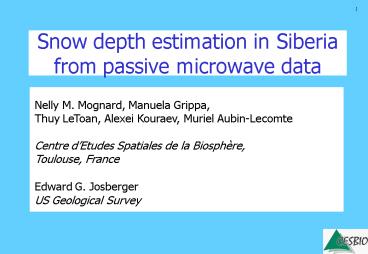Snow depth estimation in Siberia from passive microwave data - PowerPoint PPT Presentation
1 / 19
Title:
Snow depth estimation in Siberia from passive microwave data
Description:
SSM/I Dynamic Snow Water Equivalent algorithm validated with 300 in situ stations measurements ... Snow grain size metamorphism: Dynamic Algorithm major ... – PowerPoint PPT presentation
Number of Views:100
Avg rating:3.0/5.0
Title: Snow depth estimation in Siberia from passive microwave data
1
Snow depth estimation in Siberia from passive
microwave data
Nelly M. Mognard, Manuela Grippa, Thuy LeToan,
Alexei Kouraev, Muriel Aubin-Lecomte Centre
dEtudes Spatiales de la Biosphère, Toulouse,
France Edward G. Josberger US Geological Survey
2
Oceanic Circulation
Atmospheric Circulation
Vegetation Functionning
Freshwater budget
SNOW
Permafrost
Terrestrial Ecosystems C H2O Cycles
River Runoff
3
Snow Information Requirements
- Snow Covered Area
- Dates of start and end of snow accumulation
- Snow Water Equivalent
Passive Microwave Radiometers
- Long time series 20 year of SMM-R, SSM/I
- Minimum atmospheric and sun effects
- Basic principle of parameter recovering
- snow extent emissivity contrast between snow
covered and snow free ground - start and end
of snow pack difference in emissivity
between snow and liquid water - snow water
equivalent from snow depth attenutation of
emitted radiation by volume scattering
4
Comparison Satellite SWE, LaD model SWE,
Climatology SWE and NCEP air temperatures
ETAC Climatology (US Air Force Environmental
Technical ApplicationsCenter)
5
Satellite Passive Microwave estimates of snow
depth with a dynamic algorithm
- Generic retrieval algorithm to globally estimate
snow depth from Satellite Passive Microwave
Brightness Temperature - Major hypothesis the main contributing factor
to snow metamorphosis is the thermal gradient in
the snow layer especially early in the snow
season - Dynamic algorithm allows spatio-temporal
heterogeneities in the snow pack snow crystal
size varies in space and time
6
Dynamic algorithm
- Takes in to account snow grain size metamorphism
in time and space. - Requires surface air and ground temperature
information.
7
Dynamic approach
8
Ground truth 300 stations
Validation of Dynamic Algorithm in the US
Northern Great Plains
SSM/I Dynamic Snow Water Equivalent algorithm
validated with 300 in situ stations
measurementsSnow grain size metamorphism
Dynamic Algorithm major improvement compared to
classical Static Algorithm
Dynamic Algorithm
Static Algorithm
9
Combined dynamic static algorithm
10
Results
SSM/I data 1988 -2001 SSM-R data
1979-1987 Snow depth values calculated for
each pentade (every five days). Validation of
the SSM/I derived snow depth values using
- climatology from ETAC (US Air
Force Technical
Applications Center)
- meteo sation data from HSDSD
(Historical Soviet
Database Snow Depth)
11
Algorithm validation -I
Snow depth over Siberia for January. SSM/I data
have been averaged over the time period
1988-2001.
12
Algorithm validation -I
Snow depth over Siberia for January. SSM/I and
precipitation data have been averaged over the
time period 1988-2001.
13
Algorithm validation -II
Snow depths means for January for different
vegetation zone (from IIASA)
Dynamic Static Climatology Snow Storage2
14
Algorithm validation -II
The dynamic algorithm yields improved results
over the static algorithm, especially in the
regions of Steppe, Middle taiga and Tundra
15
Algorithm validation -III Comparison with meteo
station data from HSDSD
For each vegetation type, mean values are
calculated over the pixels correspondent to
the meteo station location
16
(No Transcript)
17
Algorithm further improvements
- Topography and vegetation effects
- Use of dynamic map of permafrost temperatures
Applications
Acknowledgements This work has been done in
the framework of the Siberia-II project
18
Relationship between satellite-derived snow and
vegetation parameters in Siberia Manuela Grippa,
Thuy Le Toan, Nelly Mognard, Nicolas Delbart,
Julien LHermitte, Alexei V. Kouraev and Muriel
Aubin-Lecomte
Centre d Etudes Spatiale de la BIOsphére,
Toulouse, France
Mean values over 1988-2001
Correlation between the interannual variations of
NDVI and the variations of snow and
meteorological parameters
19
TOPEX/Poseidon ground tracks over Ob river
watershed.
Typical hydrograph (in situ data, 2001) and
seasonal distribution of discharge
Annual discharge at Salekhard from TOPEX/Poseidon
(modelled) and in situ (RIMS) data
Level (TOPEX/Poseidon) and discharge (in situ)
relation for Salekhard, according to various
hydrological phases































